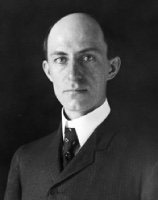 |
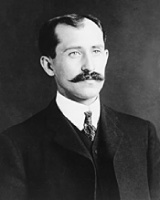 |
| Wilbur Wright | Orville Wright |
Kitty Hawk
 |
 |
| Wilbur Wright | Orville Wright |
Wilbur Wright and his younger brother Orville lived in Dayton, Ohio, USA. The boys were investigative and especially interested in technology. Eventually, they would become the greatest pioneers of aviation, having just simple education at school. They did not visit a university and Orville even did not finish secondary education. Wilbur read a lot about mathematics. Orville did read a lot, but was interested in other matters too. For instance printing a paper. When he was 17 years old, he built a big printing press for his paper.
In 1892 the brothers, who could go on with each other very well, came a bit closer to the aeroplane, without knowing. They had bought some "safety bicycles" with chain and wheels. This turned out to be much better than the velocipedes with the one big wheel. At the end of the year they were the owners of their own bicycle shop! In 1896 they started their own bicycle factory. About this time they started to become interested in aviation. They read everything they could lay their hands on. They made observations themselves and especially studied the way the birds restored their balance, when they lost it by a gust of wind. Knowing that, they hit upon the idea of flexing the tips of the wings of their aeroplanes. This was a kind of control. They tested it at first with a kite. They were so satisfied with this idea that they started looking for a place suitable for a bigger earoplane. They found it in the Kill Devil Hills near the little village of Kitty Hawk. This is situated close to the beach in North Carolina. The reason for choosing this spot was because of the ever-present winds.
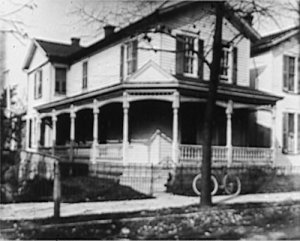 |
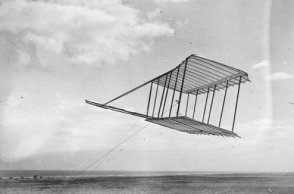 |
| The home of their parents with in front their new "safety bicyle" | The controllable kit. It resembles their definitive aeroplane. |
Autumn always meant a quiet time for their bicycle factory, so in September 1900 they had ample time to test their glider behind the beach of Kitty Hawk. The aeroplane had two wings and the pilot had to lie face down on the lower wing. In the autumn of 1900 they had made flights of 90 to 120 meters. At the end of October they packed in their tents and went home.
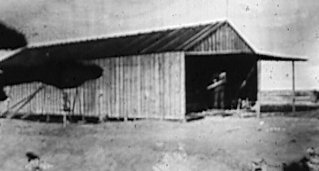 The
following winter they made plans for an improved glider and in July 1091 they
returned to Kitty Hawk. The most experienced mechanic, Taylor, ran the business
in Dayton.
In Kitty Hawk the brothers built a wooden shed.
The
following winter they made plans for an improved glider and in July 1091 they
returned to Kitty Hawk. The most experienced mechanic, Taylor, ran the business
in Dayton.
In Kitty Hawk the brothers built a wooden shed.
The aeroplane had bigger wings and they had
changed the shape of the wing. They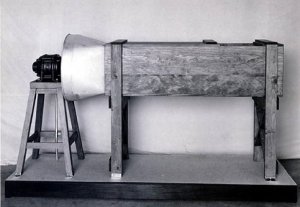 had added a stabilo, which made it possible to fly lower and higher (the pitch
control). It glided well and had a repair after a bad landing. It was very
sensitive to the controls, however. Something was wrong. The brothers started to doubt
the calculations by Otto Lilienthal. They spend the winter to do more research
in a wind tunnel. This was already invented in 1870, but nobody had used this
until Orville and Wilbur tested all kinds of wing profiles in it. Their wind
tunnel consisted of a wooden shaft with a ventilator in front. This ventilator
caused quite a flow of air, so their wings started "flying". Through a
little window they could observe the little wings and tested the lift of different
profiles.
had added a stabilo, which made it possible to fly lower and higher (the pitch
control). It glided well and had a repair after a bad landing. It was very
sensitive to the controls, however. Something was wrong. The brothers started to doubt
the calculations by Otto Lilienthal. They spend the winter to do more research
in a wind tunnel. This was already invented in 1870, but nobody had used this
until Orville and Wilbur tested all kinds of wing profiles in it. Their wind
tunnel consisted of a wooden shaft with a ventilator in front. This ventilator
caused quite a flow of air, so their wings started "flying". Through a
little window they could observe the little wings and tested the lift of different
profiles.
Lift is a force that moves the wing upwards when wind passes by.
They discovered that the wing should be slender.
August 1902 the returned in Kitty Hawk. Their glider had a bigger wingspan, a better pitch control and for the first time a tailplane. Gliding went well, but the plane sometimes made treacherous rolls causing the wing come far too low, hitting the sand every now and then. At one occasion the aeroplane was destroyed. But as ever, it was soon repaired.
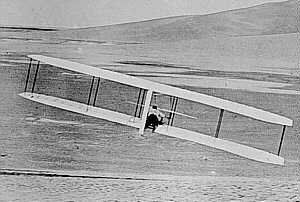 Wilbur
and Orville went on and made flights up to 165 meters, in 25 seconds time. Now they decided to add a movable tail! Nowadays this is called the rudder (for
directional steering). October 24, Wilbur made the first turn to the right!
Wilbur
and Orville went on and made flights up to 165 meters, in 25 seconds time. Now they decided to add a movable tail! Nowadays this is called the rudder (for
directional steering). October 24, Wilbur made the first turn to the right!
After three years of studying, experimenting they had surpassed all others
researchers. They even were so confident that they decided to make a
motorized flight in 1903.